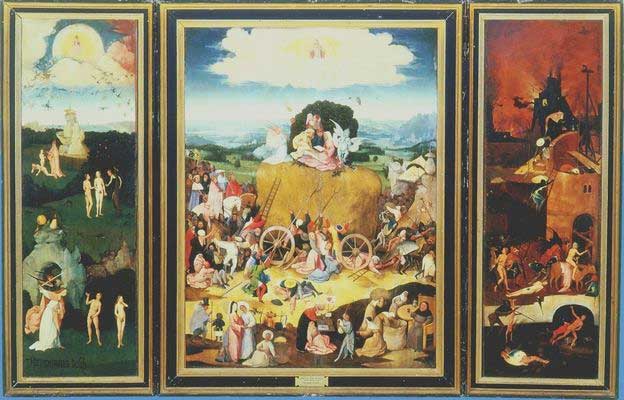Paintings

The Hay Wain.
between 1510 and 1520
Oil on panel
Ca. 140 × 200 cm (55.12 × 78.74 in)
Monasterio de El Escorial, San Lorenzo de El Escorial
Provenance:
by 1563: Felipe de Guevara (1500-1563) (?)
1563: inherited by Beatrix de Haro
(?)
1570: purchased by Philip II of Spain (1527-1598) from Beatrix de Haro
(?)
Two versions of this triptych exist, one in El Escorial, the other in Museo del Prado. Both are most probably copies of a lost Bosch original. The outer panels form a single image, usually referred to as The Path of Life.
Haywain is a triptych panel painting by Hieronymus Bosch, begun in 1485 and completed in 1490. The centre panel measures 140 by 100 cm, and the wings measure 147 by 66 cm. The Haywain triptych exists in two versions, one in El Escorial, the other in the Museo del Prado, Madrid, Spain. The outside shutters of the triptych are titled The Path of Life. They feature a character who is a version of Bosch's The Wayfarer.
Interior overview and comparison with The Garden of Earthly Delights
The Haywain triptych has a similar narrative to the The Garden of Earthly Delights. The left panel shows God as he creates Eve. Unlike the Garden, though, a narrative sequence flows through the panel in different scenes. At the top, the rebel angels are cast out of Heaven while God sits enthroned, the angels turning into insects as they break through the clouds. Below this, God creates Eve from the rib of Adam. Next, Adam and Eve find the serpent and the tree; the serpent offers them an apple. Finally, at the lowest part of the panel, the angel forces the two out of the Garden of Eden. Adam speaks with the angel; Eve looks ahead to the right in a melancholic pose.
The central panel features a massive wagon of hay surrounded by hundreds of figures engaged in a variety of sins, not just the sin of lust which dominates the Garden of Earthly Delights. In the center panel Bosch shows Christ in the sky, not paralleled in the Garden. An angel on top of the wagon looks to the sky, praying, whereas none of the other figures see Christ looking down on the world. The rightward bow of the figures around the wagon provides the force for the viewer’s eye to move with them on their journey, leading to Hell. The forward kinetic motion of the participants moves the viewer from present-day sin into unadulterated torture in the realms of Hell. The procession on the left side of this panel bends back into the middle ground, but the right side figures continue in a straight line as the wagon, giving the viewer a more evident progress into damnation.[1]
[1] ^ Minnick, Nathaniel. Hieronymus Bosch’s Triptychs in the Netherlandish Tradition, (University of Michigan, 2005)
From Wikipedia. Text is available under the Creative Commons Attribution-ShareAlike License
